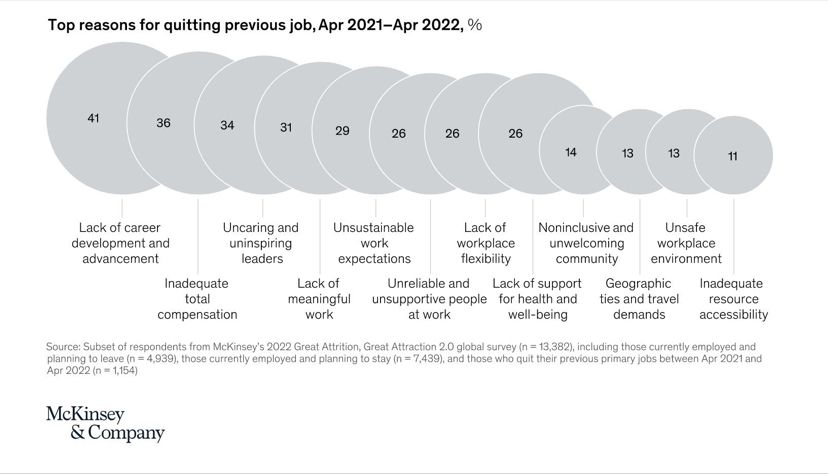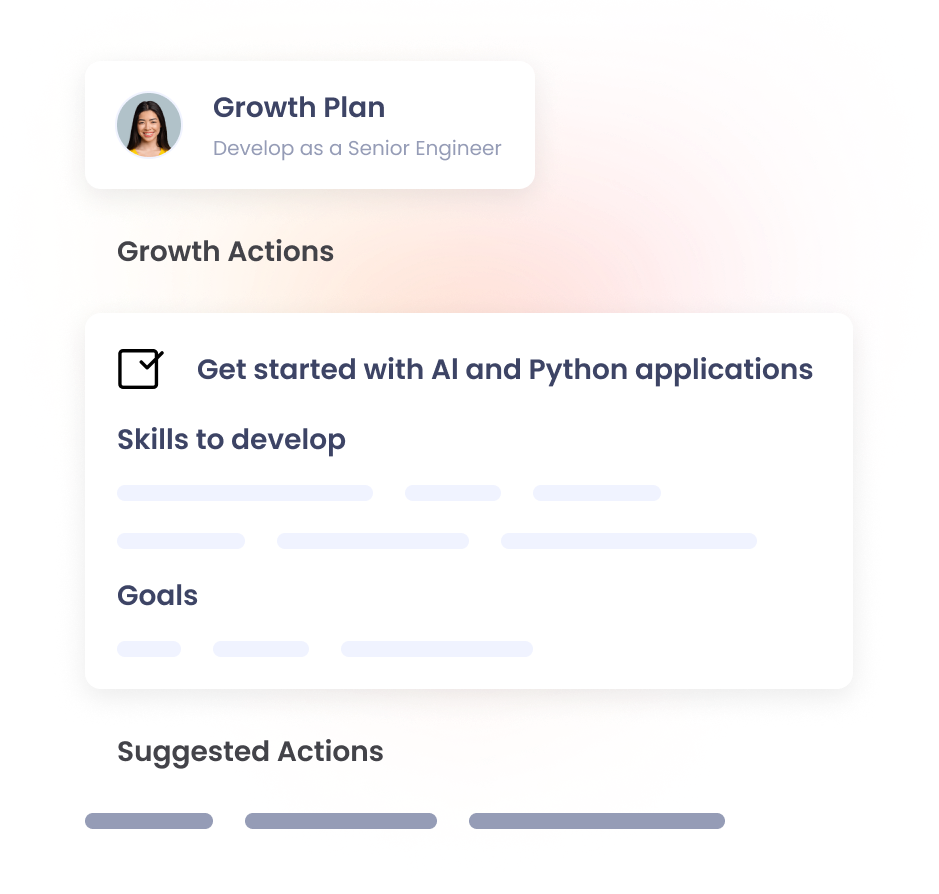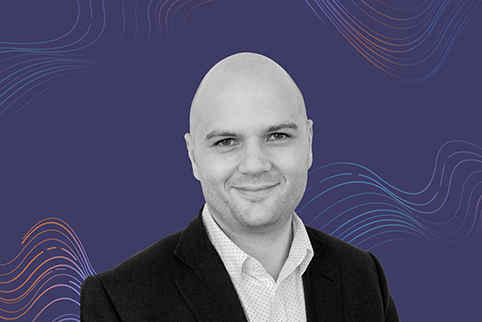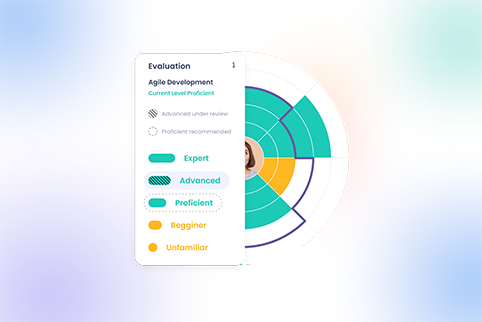Skills-Based Employee Development Plan. A Step-By-Step Guide
7 min read

Lack of career growth — and, indirectly, of an effective employee development plan — is the top reason why people quit jobs, higher than inadequate compensation, a recent McKinsey & Company study reveals.

For most generations in the workforce today, evolving with the role has become a must, especially for the younger generations. Gen Zers are also entering the workforce in record numbers, bringing a significant shift in hiring patterns.
These people want to know that their work matters and they are longing for a chance to grow and develop in their jobs. And they want it fast. This digital-native generation has lived in a world with instant experiences and they expect it too in their professional lives. Growing and advancing in their career is one of the main goals and they are more likely to change jobs if this thing doesn’t happen. And this is where the role of employee development plans comes in.
Why traditional employee development plans no longer work
There are companies that invested huge amounts of money over the years in L&D programs as a way to enable career development. Still, some of them failed to achieve impactful transformations. One of the two main reasons cited by an EY workplace report was that most L&D is focused on developing skills that were relevant yesterday, not skills for tomorrow.
Today, organizations need to build adaptability and agility to keep pace with the digital environment and map out career paths specific to each individual’s talent and aspirations so they can grow in their role and feel empowered to take on new opportunities.
Still, employee development plans, which are in fact roadmaps designed to help individuals improve and expand their skills, capabilities, and knowledge need robust preparation. In a nutshell, these concepts translate into:
- the right skill sets
- the most appropriate learning and growth opportunities
- a match between future business needs and people’s desires and aspirations
Furthermore, realigning HR processes to match skill needs can lower training and development program costs by 50 percent, according to McKinsey & Company.
So, let’s get started! Here’s how to create an effective skills-based employee development plan in your workplace:
1. Define your business needs and the most critical skill sets
To guide your people into their development journey, you need to prioritize your business objectives in the short and mid-term and decide what actions, job roles, and skill sets are the most critical to driving growth and enabling organizational success.
You need to determine your organization’s objectives first, so you can make informed decisions on how to develop your people. Employee development plans should be tailored according to different scenarios. You may want to help employees assume a leadership role, which needs a new type of soft skills or you might just need to boost efficiency.
Either way, this means getting your skills strategy off the ground. In such a fast-paced environment as seen today, with so much transformation impacting our work, it became imperative to constantly evolve and adapt — and this includes skills.
We have seen many research studies in the past years showing that most of the skills we rely on today will become obsolete in the near future. So identifying the future skills needed and linking them to job roles or business needs has turned into a necessity not only for innovation and growth but also for performing daily tasks more efficiently.
2. Conduct a skills gap analysis to understand the current state
Any cohesive development plan for the employees should start with assessing the current situation. Each employee is different and needs different types of skills at different proficiency levels to perform his job.
People intelligence platforms like Nestor can help you get this job done a lot easier. You can start by creating a skills library and assign different skill sets to each type of job role in your organization. Then set proficiency levels. Finally, asses each employee’s skills based on:
- direct manager reviews
- other peers’ reviews
- self-assessment
We go further with this approach and link skills to OKRs and goals, performance reviews, feedback, or pulse surveys, so that you get a complete view of each employee’s potential and engagement in the workplace in close connection with skills.
You may conclude that some employees need to develop new types of skills to be more productive and reach their objectives or maybe just enhance some type of soft skills and behaviors that are critical to agile company culture.
Either way, by having a clear picture, companies can address existing competency gaps so that managers can create and assign personalized development goals for employees, and initiate learning and mentorship programs or additional training.
For additional advice on how to conduct a skills mapping, check out our dedicated resource on the topic.
3. Make your people part of the process by understanding what they want
Once you have defined your business needs and set off the ground on your skills-based strategy for an employee development plan, it’s equally important to understand your people’s career goals.
Each employee has different expectations and the ideal situation is to find a match between your business needs and your people’s desires and aspirations. Not all your employees are eager to advance in leadership roles, one of them might just want lateral moves or simply take a reconversion path ahead.
Use 1:1 meetings to ask employees about their career goals, what skills they would like to develop, and where they see themselves in the future. Any comprehensive employee development plan should include your people’s expectations and growth opportunities they find suitable.
4. Set up the plan for upskilling, reskilling, and cross-skilling using clear development objectives
Based on the steps detailed above, now’s the time to define and launch specific initiatives for upskilling, reskilling, and cross-skilling your employees. To address the existing skills gap, you might look into:
- mentorship programs
- coaching
- training courses
- job shadowing
- different L&D courses
Even though the methods of learning can take on many different forms, fostering a culture of continuous learning has multiple benefits. Ongoing learning and skill development — practices embraced lately outside the boundaries of formal education — are essential to surviving economic and technological disruption.
Besides keeping your workforce adaptable and flexible to change, the continuous learning process is positive for health also. A Neurology report dating back to 2015 shows that learning activities can help delay symptoms of Alzheimer’s disease, preserving people’s quality of life.
But in the process of choosing the most appropriate methods of learning, it’s imperative to also set clear development objectives. To put this into perspective, an employee development plan should have a clear timeline agreed upon with the employees and different milestones.
It should mirror the ultimate goal at the individual level (for example, getting into a management position) and the company’s goal (for example, launching a new strategic project with a new team assigned).
5. Track the progress achieved
To know whether your employee development plan is effective, you need to track the results, monitor them closely, and adjust them accordingly.
With an application like Nestor, you have full visibility of employees’ development and how their skills and capabilities have varied over time. Moreover, you can easily set up objectives for development, invite contributors to help you reach your objectives, and see how this impacts directly both your key results as well as the company’s goals.

6. Ask for feedback to improve along the way
Tracking progress should not be the final step when crafting an employee development plan. Close the loop by asking for feedback.
Take time to understand your employees’ perspectives, if they encountered any obstacles in the learning process, and whether the method is suitable for them.







